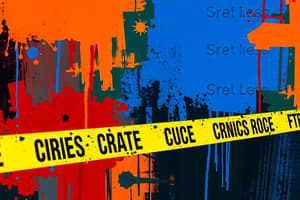Podcast
Questions and Answers
What is the primary purpose of forensic photography in a criminal investigation?
What is the primary purpose of forensic photography in a criminal investigation?
- To assist in legal proceedings by providing precise documentation of events. (correct)
- To replace the need for physical evidence in court.
- To document evidence with emotional impact for family members.
- To create a dramatic representation of crime scenes for media consumption.
Which element is NOT a principle of forensic photography?
Which element is NOT a principle of forensic photography?
- Accuracy and Clarity
- Scale and Reference
- Creative Angles for Aesthetic Appeal (correct)
- Proper Lighting
What type of photography specifically focuses on capturing physical evidence at a crime scene?
What type of photography specifically focuses on capturing physical evidence at a crime scene?
- Forensic Landscape Photography
- Victim Photography
- Crime Scene Photography
- Evidence Photography (correct)
Which camera feature is most beneficial for capturing fine details in forensic photography?
Which camera feature is most beneficial for capturing fine details in forensic photography?
Why is it important to control lighting in forensic photography?
Why is it important to control lighting in forensic photography?
What role do tripods play in forensic photography?
What role do tripods play in forensic photography?
Why is maintaining a chain of custody crucial in forensic photography?
Why is maintaining a chain of custody crucial in forensic photography?
Which imaging technique is specifically mentioned for finding latent fingerprints?
Which imaging technique is specifically mentioned for finding latent fingerprints?
What is a primary function of forensic photography?
What is a primary function of forensic photography?
Which statement reflects an ethical consideration in forensic photography?
Which statement reflects an ethical consideration in forensic photography?
Flashcards
What is the purpose of forensic photography?
What is the purpose of forensic photography?
Forensic photography captures crime scenes and evidence to preserve them for legal proceedings. It helps reconstruct events, identify individuals and items, and reduces reliance on often biased witness testimony.
What is crime scene photography?
What is crime scene photography?
This type of photography captures the entire crime scene, including the layout, objects, and any injuries. It sets the stage for understanding the events that took place.
What is evidence photography?
What is evidence photography?
Evidence photography focuses on specific items found at the crime scene. It includes close-up shots that reveal details like fingerprints, bullet holes, or marks. This documentation helps reconstruct the events accurately.
What is victim photography?
What is victim photography?
Signup and view all the flashcards
What are the key principles of forensic photography?
What are the key principles of forensic photography?
Signup and view all the flashcards
Tripods: Why are they important?
Tripods: Why are they important?
Signup and view all the flashcards
Reconstruction of Events
Reconstruction of Events
Signup and view all the flashcards
Identification of Evidence
Identification of Evidence
Signup and view all the flashcards
Court Presentations of Evidence
Court Presentations of Evidence
Signup and view all the flashcards
Chain of Custody
Chain of Custody
Signup and view all the flashcards
Study Notes
Purpose of Forensic Photography
- Forensic photography documents crime scenes and evidence precisely and accurately.
- Photographs aid in reconstructing events, identifying individuals or items, and preserving evidence for legal proceedings.
- It's a crucial documentation tool for law enforcement, reducing reliance on potentially unreliable witness testimony.
Types of Forensic Photography
- Crime Scene Photography: Documents the entire scene, highlighting layout, object positions, and injuries.
- Critical for establishing the context of events.
- Involves multiple angles, close-ups, and overall views.
- Evidence Photography: Records physical evidence (items, injuries, etc.).
- Close-up shots reveal details like fingerprints, bullet holes, or marks.
- Precisely details evidence's condition and location for accurate reconstruction.
- Victim Photography: Images of victims are captured following legal guidelines respecting dignity and privacy.
- Documents wounds and injuries meticulously.
- Focuses on clarity and accuracy, prioritizing objectivity over emotional impact.
- Other types:
- Still life photography of physical evidence.
- Digital recordings document video evidence appropriately.
Principles of Forensic Photography
- Accuracy and Clarity: Images must be clear, sharp, and detail-oriented without distortion.
- Proper Lighting: Controlled lighting provides clear visibility, avoiding harsh shadows. Strategic use of flash is possible.
- Scale and Reference: Objects are photographed with a clear scale (ruler, measuring tape).
- Angle of View: Correct angles ensure accurate depiction of size, shape, and position.
Equipment and Techniques
- Cameras: High-resolution digital cameras are commonly used for flexibility, storage, and sharing.
- Lenses: Diverse lenses (different focal lengths) are used for close-ups and wider shots based on the scene and evidence. Lenses with macro capabilities are beneficial.
- Tripods: Essential for stability to eliminate camera shake, crucial for clear images in low light and for long exposure times; uniform camera position is critical.
- Imaging Techniques: Ultraviolet (UV) and infrared (IR) light aids in latent fingerprint detection and other forensic analysis.
Roles of Photography in Investigations
- Reconstruction of Events: Images visually recreate the sequence of events at a crime scene.
- Identification of Evidence: Detailed images assist in identifying specific items, injuries, or features.
- Court Presentations of Evidence: Photographic evidence is presented professionally, meeting legal standards of reliability for admissibility.
- Accurate Record-Keeping: Forensic photography creates a verifiable record of evidence establishing a timeline and identifying potential issues.
Importance of Chain of Custody
- Crucial for any investigation.
- Forensic photographers meticulously document handling (who, when, how) for image integrity.
- Proper chain of custody ensures admissibility in court.
- Detailed records are necessary.
Ethical Considerations
- Respecting privacy of involved individuals adheres to legal and ethical guidelines.
- Images must be handled to safeguard privacy.
- Images are captured objectively and fairly.
- Balancing the rights and sensitivity of individuals and the need for high-quality forensic evidence is important.
- Ethical standards are paramount in practice.
Studying That Suits You
Use AI to generate personalized quizzes and flashcards to suit your learning preferences.




